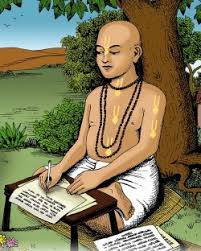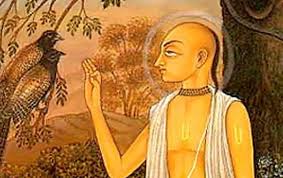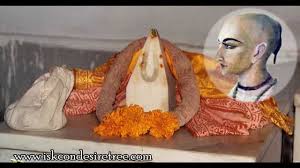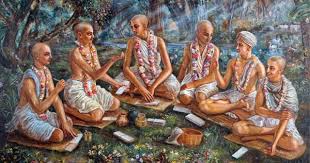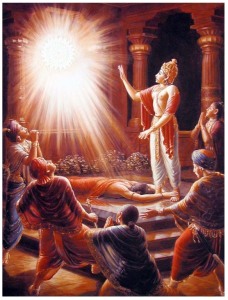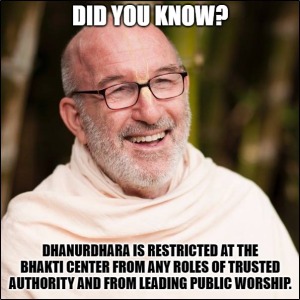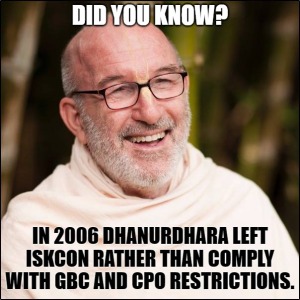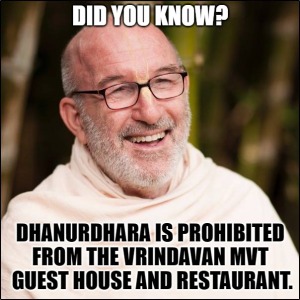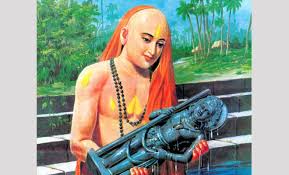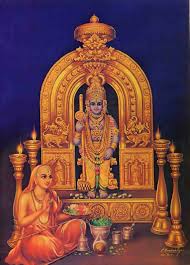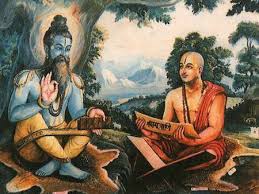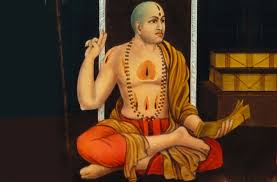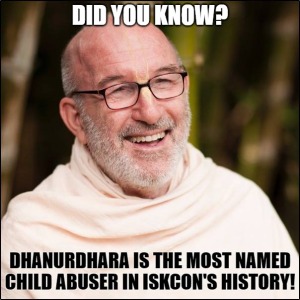 Today is the auspicious disappearance day of three great acharyas in the Gaudiya-Vaishnava sampradaya: Srila Raghunatha dasa Gosvami, Srila Raghunatha Bhatta Gosvami, and Srila Krishnadasa Kaviraja Gosvami. We shall read about Srila Raghunatha Bhatta Gosvami from Srila Krishnadasa Kaviraja’s Sri Caitanya-caritamrta.
Today is the auspicious disappearance day of three great acharyas in the Gaudiya-Vaishnava sampradaya: Srila Raghunatha dasa Gosvami, Srila Raghunatha Bhatta Gosvami, and Srila Krishnadasa Kaviraja Gosvami. We shall read about Srila Raghunatha Bhatta Gosvami from Srila Krishnadasa Kaviraja’s Sri Caitanya-caritamrta.
Sri Caitanya-caritamrta, Antya-lila, Chapter Thirteen: “Pastimes with Jagadananda Pandita and Raghunatha Bhatta.”
TEXT 89
etha tapana-misra-putra raghunatha-bhattacarya
prabhure dekhite calila chadi’ sarva karya
TRANSLATION
During this time, Raghunatha Bhattacarya, the son of Tapana Misra, gave up all his duties and left home, intending to meet Sri Caitanya Mahaprabhu.
TEXT 90
kasi haite calila tenho gauda-patha diya
sange sevaka cale tanra jhali vahiya
TRANSLATION
Accompanied by a servant carrying his baggage, Raghunatha Bhatta started from Varanasi and traveled along the path leading through Bengal.
TEXT 91
pathe tare milila visvasa-ramadasa
visvasa-khanara kayastha tenho rajara visvasa
TRANSLATION
In Bengal he met Ramadasa Visvasa, who belonged to the kayastha caste. He was one of the king’s secretaries.
PURPORT by Srila Prabhupada
The words visvasa-khanara kayastha indicate a secretary or clerk belonging to the kayastha caste. Kayasthas were usually secretaries to kings, governors, or other important persons. It is said that anyone working in the government secretariat at this time was a kayastha.
TEXT 92
sarva-sastre pravina, kavya-prakasa-adhyapaka
parama-vaisnava, raghunatha-upasaka
TRANSLATION
Ramadasa Visvasa was very learned in all the revealed scriptures. He was a teacher of the famous book Kavya-prakasa and was known as an advanced devotee and worshiper of Raghunatha [Lord Ramacandra].
PURPORT
Commenting on the word parama-vaisnava, Srila Bhaktivinoda Thakura says that anyone who desires to merge into the existence of the Lord cannot be a pure Vaisnava, but because Ramadasa Visvasa was a great devotee of Lord Ramacandra, he was almost a Vaisnava. In those days, no one could distinguish between a pure Vaisnava and a pseudo Vaisnava. Therefore Ramadasa Visvasa was known as a Vaisnava because he worshiped Lord Ramacandra.
TEXT 93
asta-prahara rama-namajapena ratri-dine
sarva tyaji’ calila jagannatha-darasane
TRANSLATION
Ramadasa had renounced everything and was going to see Lord Jagannatha. While traveling, he chanted the holy name of Lord Rama twenty-four hours a day.
TEXTS 94–102
When he met Raghunatha Bhatta on the way, he took Raghunatha’s baggage on his head and carried it.
Ramadasa served Raghunatha Bhatta in various ways, even massaging his legs. Raghunatha Bhatta felt some hesitation in accepting all this service.
“You are a respectable gentleman, a learned scholar, and a great devotee,” Raghunatha Bhatta said. “Please do not try to serve me. Just come with me in a happy mood.”
Ramadasa replied, “I am a sudra, a fallen soul. To serve a brahmana is my duty and religious principle.
“Therefore please do not be hesitant. I am your servant, and when I serve you my heart becomes jubilant.”
Thus Ramadasa carried the baggage of Raghunatha Bhatta and served him sincerely. He constantly chanted the holy name of Lord Ramacandra day and night.
Traveling in this way, Raghunatha Bhatta soon arrived at Jagannatha Puri. There he met Sri Caitanya Mahaprabhu with great delight and fell at His lotus feet.
Raghunatha Bhatta fell straight as a rod at the lotus feet of Sri Caitanya Mahaprabhu. Then the Lord embraced him, knowing well who he was.
Raghunatha offered respectful obeisances to Sri Caitanya Mahaprabhu on behalf of Tapana Misra and Candrasekhara, and the Lord also inquired about them.
TEXT 103
“bhala ha-ila aila, dekha ‘kamala-locana’
aji amara etha kariba prasada bhojana”
TRANSLATION
“It is very good that you have come here,” the Lord said. “Now go see the lotus-eyed Lord Jagannatha. Today you will accept prasada here at My place.”
TEXTS 104–111
The Lord asked Govinda to arrange for Raghunatha Bhatta’s accommodations and then introduced him to all the devotees, headed by Svarupa Damodara Gosvami.
Thus Raghunatha Bhatta lived with Sri Caitanya Mahaprabhu continuously for eight months, and by the Lord’s mercy he felt increased transcendental happiness every day.
He would periodically cook rice with various vegetables and invite Sri Caitanya Mahaprabhu to his home.
Raghunatha Bhatta was an expert cook. Whatever he prepared tasted just like nectar.
Sri Caitanya Mahaprabhu would accept with great satisfaction all the food he prepared. After the Lord was satisfied, Raghunatha Bhatta would eat His remnants.
When Ramadasa Visvasa met Sri Caitanya Mahaprabhu, the Lord did not show him any special mercy, although this was their first meeting.
Within his heart, Ramadasa Visvasa was an impersonalist who desired to merge into the existence of the Lord, and he was very proud of his learning. Since Sri Caitanya Mahaprabhu is the omniscient Supreme Personality of Godhead, He can understand the heart of everyone, and thus He knew all these things.
Ramadasa Visvasa then took up residence in Jagannatha Puri and taught the Kavya-prakasa to the Pattanayaka family [the descendants of Bhavananda Raya].
TEXT 112
asta-masa rahi’ prabhu bhatte vidaya dila
“vivaha na kariha” bali’ nisedha karila
TRANSLATION
After eight months, when Sri Caitanya Mahaprabhu bade farewell to Raghunatha Bhatta, the Lord flatly forbade him to marry. “Do not marry,” the Lord said.
PURPORT
Raghunatha Bhattacarya had become a greatly advanced devotee while still unmarried. Sri Caitanya Mahaprabhu could see this, and therefore He advised him not to begin the process of material sense gratification. Marriage is a concession for people who are unable to control their senses. Raghunatha, however, being an advanced devotee of Krsna, naturally had no desire for sense gratification. Therefore Sri Caitanya Mahaprabhu advised him not to enter the bondage of marriage. Generally a person cannot make much advancement in spiritual consciousness if he is married. He becomes attached to his family and is prone to sense gratification. Thus his spiritual advancement is very slow or almost nil.
COMMENT by Giriraj Swami
I once had the good fortune to receive a similar instruction from Srila Prabhupada. We were in Gorakhpur, and Prabhupada had received the latest issue of Back to Godhead, with an article I had written in Boston before I went to India—“The Genuine Spiritual Master.” He was pleased with the article and asked to see me. I was still quite young in Krishna consciousness, and Srila Prabhupada didn’t generally call for me. He said, “I have read your article, and it was very nice. You should write.” And he invited me to travel with him so he could train me how to write. Then he asked, “Do you ever think of getting married?” I said no. “Better to remain brahmachari,” he said, “and after some time I will give you sannyasa.” He said that the demands of the senses are like itches and that if you scratch the itches, the itching will get worse. It is better to tolerate the itches, and if you tolerate, gradually the itching will subside. The demands for eating and sleeping too—all of them—if we indulge them they become aggravated. But if we tolerate them, they gradually subside.
TEXT 113
“vrddha mata-pitara yai’ karaha sevana
vaisnava-pasa bhagavata kara adhyayana”
TRANSLATION
Sri Caitanya Mahaprabhu said to Raghunatha Bhatta, “When you return home, serve your aged father and mother, who are devotees, and try to study Srimad-Bhagavatam from a pure Vaisnava who has realized God.”
PURPORT
One should note how Sri Caitanya Mahaprabhu, the Supreme Personality of Godhead, advised Raghunatha Bhattacarya to learn Srimad-Bhagavatam. He advised him to understand Srimad-Bhagavatam not from professional men but from a real bhagavata, a devotee. He also advised Raghunatha Bhatta to serve his mother and father because they were both Lord Caitanya’s devotees. Anyone who wishes to advance in Krsna consciousness must try to serve the devotees of Krsna. As Narottama dasa Thakura says, chadiya vaisnava-seva nistara peyeche keba: “Without serving a self-realized Vaisnava, no one has ever been released from the materialistic way of life.” Sri Caitanya Mahaprabhu would have never advised Raghunatha Bhatta to serve ordinary parents, but since his parents were Vaisnavas, the Lord advised him to serve them.
One might ask, “Why shouldn’t ordinary parents be served?” As stated in Srimad-Bhagavatam (5.5.18):
gurur na sa syat sva-jano na sa syat
pita na sa syaj janani na sa syat
daivam na tat syat na patis ca sa syan
na mocayed yah samupeta-mrtyum
“One who cannot deliver his dependents from the path of birth and death should never become a spiritual master, a relative, a father or mother, or a worshipable demigod, nor should such a person become a husband.” Everyone naturally gets a father and mother at the time of birth, but the real father and mother are those who can release their offspring from the clutches of imminent death. This is possible only for parents advanced in Krsna consciousness. Therefore any parents who cannot enlighten their offspring in Krsna consciousness cannot be accepted as a real father and mother. The following verse from the Bhakti-rasamrta-sindhu (1.2.200) confirms the uselessness of serving ordinary parents:
laukiki vaidiki vapi ya kriya kriyate mune
hari-sevanukulaiva sakarya bhaktim icchata
“One should perform only those activities—either worldly or prescribed by Vedic rules and regulations—which are favorable for the cultivation of Krsna consciousness.”
Concerning the study of Srimad-Bhagavatam, Sri Caitanya Mahaprabhu clearly advises that one avoid hearing from a non-Vaisnava professional reciter. In this connection Sanatana Gosvami quotes a verse from the Padma Purana:
avaisnava-mukhodgirnam
putam hari-kathamrtam
sravanam naiva kartavyam
sarpocchistam yatha payah
“No one should hear or take lessons from a person who is not a Vaisnava. Even if he speaks about Krsna, such a lesson should not be accepted, for it is like milk touched by the lips of a serpent.” Nowadays it is fashionable to observe Bhagavata-saptaha and hear Srimad-Bhagavatam from persons who are anything but advanced devotees or self-realized souls. There are even many Mayavadis who read Srimad-Bhagavatam to throngs of people. Many Mayavadis have recently begun reciting Srimad-Bhagavatam in Vrndavana, and because they can present the Bhagavatam with word jugglery, twisting the meaning by grammatical tricks, materialistic persons who go to Vrndavana as a matter of spiritual fashion like to hear them. All this is clearly forbidden by Sri Caitanya Mahaprabhu. We should note carefully that since these Mayavadis cannot personally know the meaning of Srimad-Bhagavatam, they can never deliver others by reciting it. On the other hand, an advanced devotee of the Lord is free from material bondage. He personifies Srimad-Bhagavatam in life and action. Therefore we advise that anyone who wants to learn Srimad-Bhagavatam must approach such a realized soul.
COMMENT
Here Lord Chaitanya gave two instructions to Raghunatha Bhattacarya. First He instructed him to go back and serve his parents, because they were Vaishnavas. Serving Vaishnavas is most important for spiritual advancement. Srila Prabhupada remarks that Lord Chaitanya would have never advised Raghunatha Bhatta to return home to serve ordinary parents, and thus Srila Prabhupada quoted the verse gurur na sa syat sva-jano na sa syat.
One time, in Bombay, after he had finally acquired Hare Krishna Land in Juhu, Srila Prabhupada, sitting in his room in a thatched hut nearby with Mahamsa Prabhu and me, quoted the same Bhagavatam verse: “No one should become a spiritual master, no one should become a relative, no one should become a father, no one should become a mother, and no one should become a husband unless he can deliver his or her dependents from repeated birth and death.” And he gave some examples. He said that if the father is attacked, the duty of the son is to defend him, but that when Lord Nrsimhadeva attacked Hiranyakasipu, Prahlada made no effort to defend him. Rather, he glorified the attacker. But Prahlada was not at fault, because his father was not a real father—he was not helping him become liberated from the repetition of birth and death. Similarly, it is the duty of the son to obey the mother, but when Kaikeyi told Bharata to sit on the throne, he disobeyed. And he was not at fault, because Kaikeyi was not a real mother, because she was not helping him to become liberated from the repetition of birth and death and to engage in devotional service. Similarly, it is the duty of the wife to obey the husband, but when the Vedic brahmans told their wives not to go to Krishna and Balarama in the forest, their wives disobeyed. And they were not at fault, because their husbands were not real husbands, because they were not helping them become Krishna conscious. Similarly, it is the duty of the disciple to obey the spiritual master, but when Sukracarya ordered Bali Maharaja not to surrender everything to Lord Vishnu and not to keep his promise to Vishnu, Bali Maharaja disobeyed him. And Bali Maharaja was not at fault, because his spiritual master was not a real spiritual master. Then Srila Prabhupada told us, “You have left your mothers and fathers, but they are not real mothers and fathers. So you have done the right thing.”
Still, we offer respect to relatives. And, of course, for the service of guru and Krishna, a devotee may also serve relatives. In any case, the presence of a pure devotee in a family liberates the entire family.
Regarding the second instruction, Lord Chaitanya told Raghunatha Bhatta to hear and learn Srimad-Bhagavatam from a devotee. Svarupa Damodara Gosvami gave a similar instruction, that one should learn the book Bhagavata from the person Bhagavata.
In 1970, when the first groups of Western devotees went to India, Srila Prabhupada instructed Gurudas Prabhu to go to his quarters at Radha-Damodara, go through all his old papers and keep only the ones that were appropriate. The ones that were not appropriate—those that pertained to his householder life—should be destroyed. Gurudas invited me to accompany him, and when we went through Srila Prabhupada’s old papers, we found so many letters that he had written. One was to a man who had organized Bhagavata Week in Bombay and had invited Srila Prabhupada to attend. Prabhupada had written back that the Bhagavata should be heard from liberated souls who are free from pretentious religiosity, and not from Mayavadis, who have no access to the “great scripture” and who mislead the innocent public. He had informed the organizer, “Therefore I have not only refrained from attending the function myself but have advised many others not to attend as well.” Srila Prabhupada was so bold and forthright and fearless: abhaya.
TEXT 114
“punarapi eka-bara asiha nilacale”
eta bali’ kantha-mala dila tanra gale
TRANSLATION
Sri Caitanya Mahaprabhu concluded, “Come again to Nilacala [Jagannatha Puri].” After saying this, the Lord put His own neck beads on Raghunatha Bhatta’s neck.
TEXTS 115–119
Then the Lord embraced him and bade him farewell. Overwhelmed with ecstatic love, Raghunatha Bhatta began to cry due to imminent separation from Sri Caitanya Mahaprabhu.
After taking permission from Sri Caitanya Mahaprabhu and all the devotees, headed by Svarupa Damodara, Raghunatha Bhatta returned to Varanasi.
In accordance with the instructions of Sri Caitanya Mahaprabhu, he continuously rendered service to his mother and father for four years. He also regularly studied Srimad-Bhagavatam from a self-realized Vaisnava.
Then his parents died at Kasi [Varanasi], and he became detached. He therefore returned to Sri Caitanya Mahaprabhu, giving up all relationships with his home.
As previously, Raghunatha remained continuously with Sri Caitanya Mahaprabhu for eight months. Then the Lord gave him the following order.
TEXT 120
“amara ajnaya, raghunatha, yaha vrndavane
tahan yanaraha rupa-sanatana-sthane
TRANSLATION
“My dear Raghunatha, on My order go to Vrndavana and live there under the care of Rupa and Sanatana Gosvamis.
TEXT 121
“bhagavata pada, sada laha krsna-nama
acire karibena krpa Krsna bhagavan”
TRANSLATION
“In Vrndavana you should chant the Hare Krsna mantra twenty-four hours a day and read Srimad-Bhagavatam continuously. Krsna, the Supreme Personality of Godhead, will very soon bestow His mercy upon you.”
TEXT 122
eta bali’ prabhu tanre alingana kaila
prabhura krpate krsna-preme matta haila
TRANSLATION
After saying this, Sri Caitanya Mahaprabhu embraced Raghunatha Bhatta, and by the Lord’s mercy Raghunatha was enlivened with ecstatic love for Krsna.
TEXTS 123–125
At a festival Sri Caitanya Mahaprabhu had been given some unspiced betel and a garland of tulasi leaves fourteen cubits long. The garland had been worn by Lord Jagannatha.
Sri Caitanya Mahaprabhu gave the garland and betel to Raghunatha Bhatta, who accepted them as a worshipable Deity and preserved them very carefully.
Taking permission from Sri Caitanya Mahaprabhu, Raghunatha Bhatta then departed for Vrndavana. When he arrived there, he put himself under the care of Rupa and Sanatana Gosvamis.
TEXT 126
rupa-gosanira sabha ya karena bhagavata-pathana
bhagavata padite preme aulaya tanra mana
TRANSLATION
When reciting Srimad-Bhagavatam in the company of Rupa and Sanatana, Raghunatha Bhatta would be overwhelmed with ecstatic love for Krsna.
TEXT 127
asru, kampa, gadgada prabhura krpate
netra kantha rodhe baspa, na pare padite
TRANSLATION
By the mercy of Sri Caitanya Mahaprabhu, he experienced symptoms of ecstatic love—tears, trembling, and faltering of the voice. His eyes filled with tears, his throat became choked, and thus he could not recite Srimad-Bhagavatam.
TEXTS 128–130
His voice was as sweet as a cuckoo’s, and he would recite each verse of Srimad-Bhagavatam in three or four tunes. Thus his recitations were very sweet to hear.
When he recited or heard about the beauty and sweetness of Krsna, he would be overwhelmed with ecstatic love and become oblivious to everything.
Thus Raghunatha Bhatta surrendered fully at the lotus feet of Lord Govinda, and those lotus feet became his life and soul.
COMMENT
Actually, Raghunatha Bhatta Gosvami arranged for the construction of the Radha-Govinda temple in Vrindavan, which was the most beautiful and famous of all the temples in Vrindavan. So he may also give us some mercy to build a temple here.
TEXT 131
nija sisye kahi’ govindera mandira karaila
vamsi, makara kundaladi ‘bhusana’ kari’ dila
TRANSLATION
Subsequently Raghunatha Bhatta ordered his disciples to construct a temple for Govinda. He prepared various ornaments for Govinda, including a flute and shark-shaped earrings.
TEXT 132
gramya-varta na sune, na kahe jihvaya
krsna-katha-pujadite asta-prahara yaya
TRANSLATION
Raghunatha Bhatta would neither hear nor speak about anything of the material world. He would simply discuss Krsna and worship the Lord day and night.
TEXT 133
vaisnavera nindya-karma nahi pade kane
sabe krsna bhajana kare,—ei-matra jane
TRANSLATION
He would not listen to blasphemy of a Vaisnava, nor would he listen to talk of a Vaisnava’s misbehavior. He knew only that everyone was engaged in Krsna’s service; he did not understand anything else.
PURPORT
Raghunatha Bhatta never did anything harmful to a Vaisnava. In other words, he was never inattentive in the service of the Lord, nor did he ever violate the rules and regulations of a pure Vaisnava. It is the duty of a Vaisnava acarya to prevent his disciples and followers from violating the principles of Vaisnava behavior. He should always advise them to strictly follow the regulative principles, which will protect them from falling down. Although a Vaisnava preacher may sometimes criticize others, Raghunatha Bhatta avoided this. Even if another Vaisnava was actually at fault, Raghunatha Bhatta would not criticize him; he saw only that everyone was engaged in Krsna’s service. That is the position of a maha-bhagavata. Actually, even if one is serving maya, in a higher sense he is also a servant of Krsna. Because maya is the servant of Krsna, anyone serving maya serves Krsna indirectly. Therefore it is said:
keha mane, kehana mane, sabatanra dasa
ye na mane, tarahaya sei papenasa
“Some accept Him, whereas others do not, yet everyone is His servant. One who does not accept Him, however, will be ruined by his sinful activities.” (Cc Adi 6.85)
COMMENT
Srila Raghunatha Bhatta Gosvami “would not listen to blasphemy of a Vaisnava, nor would he listen to talk of a Vaisnava’s misbehavior. He knew only that everyone was engaged in Krsna’s service.” Yet in the purport, Srila Prabhupada comments that the Vaishnava acharya has to train his disciples according to the regulative principles and that if he sees that they are violating principles of Vaishnava behavior, he has to correct them. Even if the spiritual master is a maha-bhagavata, when he acts as spiritual master and takes the responsibility to train disciples, he must discriminate between proper and improper behavior. And if the disciples are behaving improperly, he must point out the defects and correct them.
When Srila Prabhupada first met his guru maharaja, Srila Bhaktisiddhanta Sarasvati Thakura, he thought that Srila Bhaktisiddhanta was simply criticizing—criticizing the fruitive workers, criticizing the mental speculators, criticizing the impersonalists. But Prabhupada remarked that later he realized that what his guru maharaja had been saying was actually correct. Sadhu also means “to cut.” The sadhu must cut people’s false attachments, and therefore he may have to criticize—not out of envy or malice, as we may criticize, but only for the sake of cutting people’s false attachments and bringing them to the proper standards of devotional service.
Once, in Indore, Srila Prabhupada was strongly criticizing some popular religious figures. One of the gentlemen in the room became very upset and said, “You should not criticize. You should see everyone equally, as atma, and you should not criticize.” Srila Prabhupada replied, “That is a very high stage, sama-darsinah.” A maha-bhagavata doesn’t criticize anyone, because he sees everyone is already serving Krishna. Then Prabhupada discussed the verse (Gita 5.18) panditah sama-darsinah:
vidya-vinaya-sampanne
brahmane gavi hastini
suni caiva sva-pake ca
panditah sama-darsinah
“The humble sages, by virtue of true knowledge, see with equal vision a learned and gentle brahmana, a cow, an elephant, a dog, and a dog-eater.”
Prabhupada said that a learned brahman is supposed to be virtuous and that a dog is supposed to be sinful. So to see a brahman and a dog equally means that one doesn’t distinguish between pious and sinful activities; one sees that everyone is serving Krishna. “But,” Srila Prabhupada said, “I am not on that stage. I say that because you don’t surrender to Krishna, you are sinful.”
So even the uttama Vaishnava, when he preaches, has to act as a madhyama Vaishnava and point out faults and correct them. But if one is not in a position to actually instruct others for their benefit, he should act like Raghunatha Bhatta Gosvami. He should avoid material talks in general and blasphemy of Vaishnavas in particular, and he should remain absorbed in his service to Krishna.
The Bhagavad-gita (17.15) confirms,
anudvega-karam vakyam
satyam priya-hitam ca yat
svadhyayabhyasanam caiva
van-mayam tapa ucyate
“Austerity of speech consists in speaking words that are truthful, pleasing, beneficial, and not agitating to others, and also in regularly reciting Vedic literature.”
And Srila Prabhupada explains in the purport, “One should not speak in such a way as to agitate the minds of others. Of course, when a teacher speaks, he can speak the truth for the instruction of his students, but such a teacher should not speak to those who are not his students if he will agitate their minds. This is penance as far as talking is concerned. Besides that, one should not talk nonsense. The process of speaking in spiritual circles is to say something upheld by the scriptures. One should at once quote from scriptural authority to back up what he is saying. At the same time, such talk should be very pleasurable to the ear. By such discussions, one may derive the highest benefit and elevate human society. There is a limitless stock of Vedic literature, and one should study this. This is called penance of speech.”
One of the divine qualities mentioned in the Bhagavad-gita (16.1–3) is apaisunam, “aversion to faultfinding.” There Srila Prabhupada comments, “Apaisunam means that one should not find fault with others or correct them unnecessarily. Of course to call a thief a thief is not faultfinding, but to call an honest person a thief is very much offensive for one who is making advancement in spiritual life.”
TEXT 134
mahaprabhura datta mala mananera kale
prasada-kadara saha bandhi lena gale
TRANSLATION
When Raghunatha Bhatta Gosvami was absorbed in remembrance of Lord Krsna, he would take the tulasi garland and the prasada of Lord Jagannatha given to him by Sri Caitanya Mahaprabhu, bind them together, and wear them on his neck.
TEXT 135
mahaprabhura krpaya krsna-prema anargala
eita’ kahilun tate caitanya-krpa-phala
TRANSLATION
Thus I have described the powerful mercy of Sri Caitanya Mahaprabhu, by which Raghunatha Bhatta Gosvami remained constantly overwhelmed with ecstatic love for Krsna.
TEXTS 136–137
TRANSLATION
In this chapter I have spoken about . . . how Raghunatha Bhatta Gosvami achieved ecstatic love of Krsna by the mercy of Sri Caitanya Mahaprabhu.
TEXT 138
ye ei-sakala katha sune sraddha kari’
tanre krsna-prema-dhana dena gaurahari
TRANSLATION
Sri Caitanya Mahaprabhu [Gaurahari] bestows ecstatic love for Krsna upon anyone who hears these topics with faith and love.
TEXT 139
sri-rupa-raghunatha-pade yara asa
caitanya-caritamrta kahe krsnadasa
TRANSLATION
Praying at the lotus feet of Sri Rupa and Sri Raghunatha, always desiring their mercy, I, Krsnadasa, narrate Sri Caitanya-caritamrta, following in their footsteps.
Thus end the Bhaktivedanta purports to Sri Caitanya-caritamrta, Antya-lila, Thirteenth Chapter, describing . . . Raghunatha Bhatta Gosvami’s achieving love of Krsna.
Giriraj Swami: Are there any questions or comments?
Devotee: In this country there are Bhagavata kathas, and sometimes people invite us to do a katha also. Should we accept the invitation to go and chant or speak?
Giriraj Swami: We should be careful, because we are quite well established in Mauritius now. We should rather hold our own programs and invite people to our programs. When Srila Prabhupada first returned to India, he accepted invitations to the Vedanta Sammelan in Amritsar and the Gita Jayanti Mahotsava in Indore because people did not know us. And by his attending such programs, people came to know us. But as soon as we became established, Prabhupada stopped accepting such invitations. In fact, when I went to Madras, one man, Mr. Ratnam Iyer, had his own organization, called Astika Samaj, and he offered to take full responsibility to arrange Srila Prabhupada’s program in Madras, but in the end, he didn’t really help, because ultimately he was a Mayavadi. He didn’t actually like us. When I informed Srila Prabhupada in a letter, Prabhupada wrote back that it is never good to have to depend on others for our preaching: “I am not surprised that Mr. Ratnam Iyer has decided to cancel the program you were planning. I was not eager to accept his proposal in the beginning, because it has been our experience that it is never good to have to depend upon others for our preaching.” We should make our own arrangements.
People sometimes invite us just to decorate their program, to attract people, and to get our stamp of approval—they try to use us for their own purposes. But we may not actually approve of their program, so we must be careful. Once, Guru-Gauranga Prabhu, Srila Prabhupada’s disciple who was based in Switzerland, arranged for His Divine Grace to meet the head of the World Health Organization (W.H.O.) in Geneva. Srila Prabhupada was so intelligent and perceptive that when he agreed to meet the person he said that no photos should be allowed. And he explained to us that the W.H.O. was trying to introduce birth control in Third World countries and considered India to be difficult because people in India understood contraceptive methods and abortion to be sinful. “So they will want to take my photo and use it to make propaganda that I approve of the World Health Organization’s program.” And that is actually what happened: at the end of the meeting, they wanted to have their photos taken with Srila Prabhupada. Because we are authorized, people want to use us to gain credibility for their programs. But we may not actually approve of their programs. So we should be careful how we associate with them and how we are perceived to be associated with them.
Krsnacandra dasa: Sri Chaitanya Mahaprabhu gave different instructions to Raghunatha Bhatta at different times. First He instructed him to serve his devotee parents and to study Srimad-Bhagavatam from a realized devotee, and then He told him to go to Vrindavan and chant Hare Krishna and take shelter of Rupa Gosvami and Sanatana Gosvami. The spiritual master gives instructions to his disciples according to time, place, and circumstances, and so the spiritual master may change his instruction.
Giriraj Swami: Yes, that is true. Once, on a morning walk on Juhu Beach, Srila Prabhupada was discussing surrender, and he was pointing out various defects in supposed surrender. One defect is that the disciple will receive an instruction from the spiritual master, and later, when the spiritual master gives a different instruction, the disciple will object: “But previously you told me such-and-such.” Srila Prabhupada said that surrender means you accept the latest instruction, the immediate instruction. Once, when he gave an instruction to a disciple and then later gave him a different instruction, the disciple said, “Srila Prabhupada, previously you told me that, and now you are telling me this.” And Srila Prabhupada replied, “If you accepted my authority then, why don’t you accept it now?” So we have to be careful not to pick and choose what instruction we like and what instruction we don’t like.
Mukta-purusa dasa: Lord Chaitanya advised that one hear Srimad-Bhagavatam from a realized soul. But how can ordinary people know who is a realized soul? Sometimes professional reciters speak very ornamentally, and they are attractive to ordinary people.
Giriraj Swami: First we must know the constitutional position of the living entity. Jivera ‘svarupa’ haya—krsnera ‘nitya-dasa’: the living entity’s constitutional position is to be an eternal servant of Krishna. One who is acting as an eternal servant of Krishna—in other words, one who is a devotee—is self-realized. He has realized that he is the eternal servant of Krishna.
How can ordinary people know who is self-realized? They have to be educated. Either in person or from books, they have to hear from devotees to be educated in the science of self-realization. Someone who is choosing where to study, in which university, will make inquiries, and only after careful consideration will he or she decide which university to attend. He or she will inquire: What is the reputation of the school? Who are the professors? What are the results of the graduates? And that’s just for a few years of academic education. So, if we take so much care to decide where to go for a few years of academic education, how much more care we should take to decide where we go for spiritual education, which will guide us in our eternal spiritual life. We have to inquire and learn.
But many people are not actually serious or sincere; they just want to make a show that they are very pious, very religious. And they may want to be entertained. But if someone is sincere and serious, he or she will try to understand the science of spiritual life from devotees. And ultimately one will come to the conclusion that one must learn from devotees.
We take knowledge from Krishna and Krishna’s representatives, and because we take knowledge from Krishna, we know that the knowledge is perfect and we don’t need to go to anyone else for knowledge. In one talk, Srila Prabhupada related how his disciple Achyutananda Prabhu had gone to distribute books at the ashram of a well-known Mayavadi sannyasi who gave Bhagavata-saptahas, and when one of the sannyasi’s disciples had canvassed him, “Why don’t you ask some question to Swamiji?” Achyutananda had replied, “No. I have nothing to question from your Swamiji.” Prabhupada continued, “So, actually bring any so-called yogi, swami, or incarnation and our student will challenge him: he does not know anything. We have got such a nice book of knowledge, Bhagavad-gita.” Srila Prabhupada was very happy, very proud. Because we are getting knowledge from Krishna and Krishna’s representatives in disciplic succession, we don’t have anything to learn from anyone else.
Devotee: What happens to the relationship between spiritual master and disciple after death?
Giriraj Swami: In principle, the relationship between the spiritual master and the disciple is eternal. If the disciple is not completely successful in his or her attempt to go back to Godhead at the end of this life, he or she gets the chance to continue the process of devotional service in the next life and to follow the same instructions that he or she received from the spiritual master in this life. So service to the spiritual master is eternal. And the spiritual master will arrange to guide the sincere disciple until he or she is completely successful and goes back home, back to Godhead.
Sri Raghunatha dasa Gosvami ki jaya!
Sri Raghunatha Bhatta Gosvami ki jaya!
Sri Krishnadasa Kaviraja Gosvami ki jaya!
[A talk by Giriraj Swami on , October 23, 1996, Hare Krishna Land, Phoenix, Mauritius]



